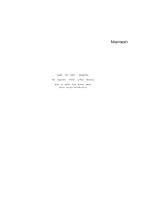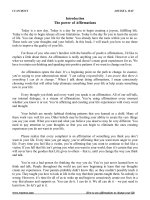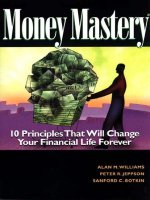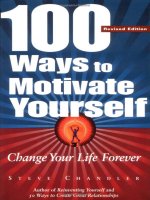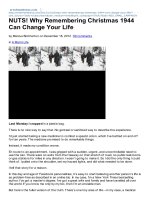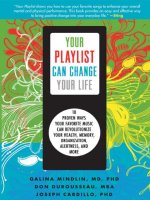Latte or Cappuccino 125 Decisions that Will Change Your Life by Hilly Janes
Bạn đang xem bản rút gọn của tài liệu. Xem và tải ngay bản đầy đủ của tài liệu tại đây (7.86 MB, 211 trang )
First published in Great Britain in 2012 by
Michael O’Mara Books Limited
9 Lion Yard
Tremadoc Road
London SW4 7NQ
Copyright © Michael O’Mara Books Limited 2012
All rights reserved. You may not copy, store, distribute, transmit, reproduce or
otherwise make available this publication (or any part of it) in any form, or by
any means (electronic, digital, optical, mechanical, photocopying, recording or
otherwise), without the prior written permission of the publisher. Any person
who does any unauthorized act in relation to this publication may be liable to
criminal prosecution and civil claims for damages.
A CIP catalogue record for this book is available from the British Library.
ISBN: 978-1-84317-877-4 in EPub format
ISBN: 978-1-84317-876-7 in Mobipocket format
ISBN: 978-1-84317-558-2 in paperback format
1 2 3 4 5 6 7 8 9 10
Disclaimer: The information contained in this book is correct to the best of the
author and publisher’s knowledge and contains the latest research at the time of
publication. It is not an alternative to seeking personalized medical advice. The
information contained is aimed at healthy adults. Pregnant women, children, the
elderly, and people who may have different requirements should seek alternative
medical advice.
Designed and typeset by K DESIGN, Somerset
Illustrations by Greg Stevenson
www.mombooks.com
Freshening Up
Shower or bath?
Short- or long-term hair removal?
Hop on the scales or measure your waist?
Mouthwash or floss?
Manual or electric toothbrush?
Regular or whitening toothpaste?
Spray, roll-on or stick deodorants and anti-perspirants?
Moisturizer and foundation with or without sun protection?
Moisturize morning or night?
Getting Dressed
Tights or stockings?
Heels or flats?
Something Extra
Exercise in the morning or evening?
Should children watch TV in the morning or later?
What to Drink
Caffeinated or decaffeinated drinks?
Freshly squeezed or juice from concentrate?
What to Eat
Cereal or eggs?
Multigrain or wholegrain?
Probiotic or regular yogurt?
Normal or reduced-fat peanut butter?
Spreads or butter?
Toast and Nutella or pain au chocolat?
Muesli or granola?
Health Supplements
Cranberry juice or a supplement?
Fish-oil supplement or a multivitamin?
Zinc or echinacea for colds?
Getting There
Walk or cycle?
Cycle helmet or bare head?
At Work
Email or a conversation?
Tricky email: respond now or later?
Managing Your Time
Perfectionism or good enough?
Make one list or several?
Keep focused or daydream?
Delegate or do it yourself?
Meet with colleagues or work independently?
Say yes or no?
Getting Along with your Colleagues
Blame others or move on?
Apologize or say nothing?
Accept or try to change decisions?
Pass on gossip or keep quiet?
Make tea and coffee for yourself or for everyone?
What to Eat and Drink
Latte or cappuccino?
Scone or muffin?
Fruit juice or smoothie?
Smoothie or fruit?
Orange or kiwi?
Peanuts or nuts and raisins?
Can of diet drink or bar of chocolate?
What to Eat
Big lunch or big supper?
Wrap or baguette?
Mayonnaise or butter?
Soup or salad?
Sushi or sashimi?
What to Drink
Fizzy water or still?
Getting Out of the Office
Exercise indoors or go out?
Meet a friend or eat alone?
Swim or run?
Sunscreen or unprotected skin?
What to Do
Do the same thing or something new?
Old friends or new?
What to Eat and Drink
A sandwich or yogurt to line your stomach?
Sweet or salted popcorn?
Nuts or crisps?
Black or green olives?
Wine or gin and tonic?
Tips for Dating
First date: drinks or dinner?
Touch or don’t touch?
Condom: sooner or later?
Eating Out
Chinese or Indian?
Garlic bread or bruschetta?
Hummus or taramasalata?
Salad as a starter or a main?
Pasta or pizza?
KFC or M cDonald’s?
Doner or shish kebab?
Red or white wine?
Shopping for Food
Organic or non-organic?
Low-fat or light?
Use by or best before?
Frozen or chilled?
Dinner Time
Eat early or late?
Eat together or separately?
Raw or cooked?
Broccoli or spinach?
Tomatoes or statins?
Sunflower or olive oil?
Cook with wine or stock?
Weigh portions or guess?
Slice of cheesecake or cheese and biscuits?
Satsuma or banana?
Domestic Life
Do the housework or hire someone else to do it?
Wash at 30 or 60 degrees?
Watch TV or play a computer game?
Have a row or bite your tongue?
The End of the Day
Soap and water or cleanser when washing your face?
Bath at night or in the morning?
Food diary or list of good things?
Have sex or go to sleep?
Insomnia: stay in bed or get up?
Treat Yourself
Sleep late or get up?
Cooked breakfast or continental?
Sunday roast or bread and cheese?
Ice cream or an ice pop?
Shopping
Buy something or do something?
Shop online or in-store?
Pay by cash or credit card?
Treat yourself or someone else?
Get Active
Multitask or do one thing at a time?
Multitask or do one thing at a time?
Clean the windows or the car?
Vacuum the floor or mow the lawn?
All your exercise now or break it up?
Run on the flat or uphill?
Run barefoot or in trainers?
Arnica or an ice pack?
Sports/energy or juice drink?
Regret or let it go?
Babies and Young Children
Homemade or ready-made baby food?
Leave babies to cry or comfort them?
Baby in bed or in a cot?
Use a straw or sip drinks?
Milkshake or ice cream?
One sport or lots?
Teenagers
Alcohol or soft drinks for teenagers?
Computer/TV in the bedroom or living room?
Teenagers: sleep late or get up?
And Finally …
Say yes or no?
Guideline Daily Amounts (GDAs)
The Lowdown on Fats
The Lowdown on Salt
The Lowdown on Sugar
High or Low?
Vitamins and Minerals
very slim, get lots of exercise, sleep like a log, feel
totally on top of your daily schedule and never shout at your
children or partner, give this book to a lesser mortal now.
If, on the other hand, you consider yourself to be a reasonably
healthy adult, but you would like to lose a little bit of weight, or
you sometimes feel overloaded and anxious about how much you
have to do, or worry that your relationships with family, friends or
colleagues are not as happy as you’d like them to be, this is the
book for you.
It’s here to help make simple the everyday decisions we often
face. The book is based on sound medical research, advice from the
most reliable experts, common sense and my own personal
experience as someone who has worked for thirty years – many of
them full-time – while looking after my family. And as a writer and
editor on quality newspapers and magazines specializing in
lifestyle, parenting and health I’ve been lucky enough to work with
leading experts in the field. This book aims to share the top-to-toe
knowledge I have built up over that time, from what neuroscience
is telling us about how our brains work to why flat shoes aren’t
necessarily good for our feet.
The book’s easy-to-digest format runs through over 120 choices
that can have an impact on our health and wellbeing from first thing
in the morning to last thing at night. Shower or bath? Do a piece of
work or delegate to a colleague? Go for a run or a swim? Wine or
gin and tonic? Pizza or pasta? Argue with your partner or bite
your tongue?
But we are drowning in healthy-living advice already, I hear you
say. We are indeed bombarded regularly with advice from health
professionals, the food, drink and fitness industries, relationship
gurus and so on, but the advice can be very confusing and seems to
change from one minute to the next. That’s partly because medical
research evolves all the time, and while no one would want to be
prescribed drugs or undergo medical procedures that have not been
rigorously tested, the words ‘studies show’ can raise a lot of
questions: who paid for the study – a drug-company with vested
interests? How and from whom was the data collected? Did the
published results include any negative findings? So it’s with these
questions in mind that I’ve tried to find the most solid sources
(listed in full on page here) to back up the choices in this book and
give you a measured assessment of the available data.
One of my aims is to demystify the confusing messages sent out
to us by the food and drink industry. Labels like ‘healthy’ or
‘natural’ sound as if they are good for us, but actually mean very
little. Food companies and supermarkets want us to eat and drink
more – tasty food that’s often full of cheap, processed ingredients
can mean big profits for them. Similarly, the catering trade offers us
bigger and bigger portion sizes, often for little extra cost. The
trouble is the more primitive, hunter-gatherer parts of our brains
find these extra portions hard to resist. Combined with our
increasingly sedentary lifestyles, it’s no wonder 60 per cent of us
are now overweight. Poor diet is raising our risk of heart disease,
diabetes and some cancers, but this can be reduced, or even
reversed, by changing how we eat, drink and exercise.
The good news is that this book is full of examples of how to
make these changes with little food and drink swaps that can make
a big difference to calorie intake, as well as fat, sugar and salt
levels – food groups that can really tip the balance towards ill
health if we don’t keep an eye on how much we are eating. Some
simply presented facts and figures about nutrition at the end of
this book on page here are designed to help you understand the
basics. There are tips, too, on how to improve the amount or type
of exercise you get and stay motivated, even if your idea of
participating in sport means jumping up and down in front of the
TV.
You may be in terrific shape, but perhaps you need some help
with relationships, or psychological problems. Some
psychologists, psychotherapists or counsellors and most
complementary therapies are not regulated by law, however, so
their advice may not be backed up by proper qualifications or
codes of conduct, and you take it at your peril. So, I have turned to
trustworthy sources, such as academics who conduct sound
research and professional associations with rigorous standards, to
underpin my advice.
Think of this book as a sort of recipe book – it’s been designed
to allow you to dip in and out of it with ease, picking the topics
you like the sound of and that you know will work for you.
Perhaps you already make some of the choices suggested in this
book. Nobody would expect you to follow it slavishly, but I hope
that if you do take up some of the suggestions, you’ll find some
ingredients for a happier, healthier life.
in the morning can leave you feeling grumpy and
anxious well into the day. Think: you can’t find the right clothes,
you’ve run out of milk and a child’s lost its homework – well, the
stress mounts. A simple routine will set you up for whatever lies
ahead.
The decisions you make in your morning bathroom routine will
perhaps be dictated by time constraints, with you or other
members of the family queuing up to use the facilities. The good
news is that most of the decisions you have to make here are
pretty quick and time saving.
Have you ever wondered why Scandinavians swear by taking a hot
sauna, followed by a dip in freezing cold water? It’s because it’s
thought to aid circulation – the heat brings the blood to the surface
of the body and the cold drives it back to its core. Why not try
jumping in the shower and adjusting the temperature of the water
to help your circulation? It also has the added benefit of boosting
the blood flow to your brain because your head is exposed to jets
of water, and directing the hot water at stiff or painful muscles also
acts as a type of massage.
Both a five-to-ten-minute bath or shower will add moisture to
the skin, but any longer in the water may leave it less hydrated
than it was before you started, according to the American
Academy of Dermatology. To counteract the effects of a long soak
in the bath or shower, the Academy recommends using a soap or
body wash that contains moisturizer, and rubbing a moisturizing
cream or lotion into still-damp skin when you’ve dried off.
Taking a shower, lifestyle gurus say, uses less water – a
precious resource as the world population grows and developing
countries’ demand increases. As personal hygiene accounts for
about a third of water requirements in the UK, it makes sense to
use as little as possible – but, as the UK’s Department of
Environment, Food and Rural Affairs (DEFRA) points out, a
shower typically uses around nine litres a minute, and if we stand
under it for more than ten, we might use more water than we would
in a bath (which, depending on the size of your bath, uses about
eighty litres). Keen greens can surf the Internet for shower timers
and collapsible buckets to collect waste water for the garden or to
wash the dog, in order to keep shower time as efficient as possible.
Not such good news for lovers of a long, relaxing soak in the bath,
so if that really is your preference see Last Thing on page here for
tips on how to get the most out of one.
There are so many ways of dealing with hairy legs, armpits and
bikini lines, all with various pros and cons, that it’s hard to say
which is right or wrong. For the short-term solution razors are
quick and convenient for legs and underarms, but you probably
wouldn’t want to use them on your bikini line or face. Shaving can
also cause irritation, cuts and even infection if the razor is not kept
clean. Shave in the direction of the hair growth, and make sure your
skin is moist. Consider using a shaving oil (the type men use on
their faces); apply body lotion afterwards to keep your skin soft
and smooth.
As for supposed longer-term solutions, creams are messier and
take longer to use but are a better option for smaller, sensitive
areas. They work by dissolving the hair, turning it into a jelly-like
substance that can easily be wiped away, and they contain
moisturizers to soothe and soften the skin. While the chemicals
they contain can be smelly, the industry has got better at masking
this with fragrances and also developing different products such as
roll-ons, sprays, and varieties that can be used in the shower.
Regrowth is softer but not slower than it is with shaving, and
creams may cause irritation or allergic reactions: always test on a
small patch of skin. They are messier, more time-consuming and
more expensive to use than a razor.
Waxing is good because it pulls the hair out from the
root – ouch. For the faint-hearted, salon visits are the obvious
option, but they are expensive, time-consuming and, of course, not
something you would do every day. The same can be said of
electrolysis and laser hair removal.
If you’re watching your weight and step on the scales in the
morning, might you be better off reaching for the tape measure to
work out if you’re piling on the pounds? Scientists are studying
this intensively because of international concerns over obesity and
the results can be confusing.
One way to assess whether or not you’re overweight is to
calculate the Body M ass Index (BM I) – your weight in relation to
your height. To work it out, divide your weight in kilos by your
height in centimetres squared (or use imperial measures). Several
websites do this for you – just Google ‘BM I’. A BMI of between
18.5 and 25 indicates a healthy weight.
Some doctors argue that waist circumference is the more useful
standard by which to judge excess weight: ‘fat around the middle’
is the real danger sign. A fat tummy is likely to have fatty organs
underneath it, which, particularly for the liver, can be dangerous.
While a March 2011 study by British doctors, for example,
disagreed with this, a more recent one in June 2011 in the US said
that waist measurement is a more reliable indicator of obesity-
related problems like heart disease and diabetes: anything above
80cm (31.5 inches) for women and 94cm (37 inches) for men
increases the risk. Not sure where your waist is? Find the top of
your hip bone and the bottom of your ribs and wrap the tape
around the halfway mark, near your belly button.
Which method to choose? To calculate your BM I you have to
be good at mental arithmetic or have access to an online calculator.
Alternatively, just admit that your jeans really are getting tighter
and reach for a tape measure. Both will help you work out if you
need to lose weight, but I know which I find easier.
Mouthwashes taste refreshing and are easy to use, but there is
little evidence that they improve dental health, although those
containing chlorhexidine, an antiseptic, can alleviate some
infections. They should be used only for short periods, however,
as they may stain your teeth. There is some evidence that
mouthwash may help improve bad breath temporarily, and the
rinsing and spitting motions will clear out little bits of debris after
brushing.
Flossing is universally recommended by dentists for removing
plaque and bacteria, and mouthwash is no substitute. Use floss in a
circular motion – don’t saw up and down, which may damage your
gums. Try the interdental brushes available from pharmacies if you
find flossing tricky. It’s good to floss at least once a day,
preferably before going to bed, but morning will do if you forgot to
floss the previous evening.
There is nothing intrinsically bad about a manual toothbrush.
According to the British Dental Association, it’s the way you
brush your teeth that counts: use small circular motions. An
electric toothbrush makes this much easier, and if you buy one
with a timer you’re more likely to keep going for the recommended
two minutes’ minimum brushing time. An overview of studies by
the Cochrane Collaboration (a respected international body that
systematically reviews health research), comparing electric
toothbrushes, suggests that those using rotation oscillation (where
the brush head rotates in one direction, then the other) reduce gum
inflammation and help with plaque removal. Some dentists
recommend that the undertens stick to the manual type unless they
are supervised: alone, they may just whiz the toothbrush around
their mouths, defeating the object of cleaning each tooth slowly.
That’s the worst of both worlds.

